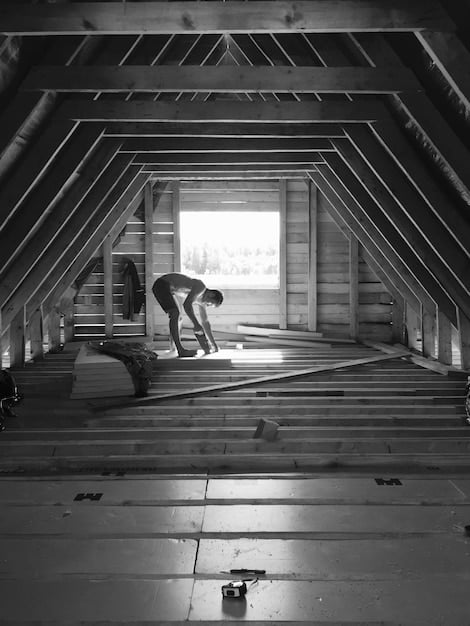Draft-Proof Your Home: Easy Ways to Save Energy This Winter

Draft-proofing your home this winter is a crucial step in reducing energy loss, thereby lowering utility bills and creating a more comfortable living environment through simple and effective measures.
As winter approaches, the chill in the air serves as a reminder to prepare our homes for the cold months ahead. One of the most effective ways to combat rising energy costs and maintain a cozy indoor temperature is by draft-proofing your home: simple steps to reduce energy loss this winter. Let’s explore some practical strategies to enhance your home’s energy efficiency.
Why Draft-Proofing Matters
Draft-proofing your home isn’t just about staying warm; it’s a smart financial decision and an environmentally conscious choice. By addressing drafts, you’re actively reducing the amount of heat that escapes from your home, forcing your heating system to work harder and consume more energy.
Effective draft-proofing can lead to substantial savings on your energy bills over the winter months, making your home more comfortable while also reducing your carbon footprint. It’s a win-win scenario for both your wallet and the planet.
Understanding Air Leaks
Air leaks are often invisible culprits that allow cold air to seep into your home and warm air to escape. Common sources include gaps around windows and doors, cracks in walls, and openings around pipes and electrical wiring.
Health and Comfort Benefits
Beyond energy savings, draft-proofing improves indoor comfort by eliminating cold spots and maintaining a consistent temperature throughout your home. It also helps to reduce allergens and pollutants that can enter through cracks and gaps, contributing to a healthier living environment.

To summarize, draft-proofing is an essential task that addresses energy efficiency, financial savings, and overall comfort, making it a priority for homeowners preparing for winter.
Identifying Drafty Areas
Before you can effectively draft-proof your home, it’s crucial to identify the areas where air leaks are most prevalent. A systematic approach to detecting these drafts will help you prioritize your efforts and ensure that you’re addressing the most significant sources of energy loss.
Locating drafty spots can be a simple DIY task, but professional energy audits can provide a more comprehensive assessment and pinpoint hidden leaks. Here’s how to get started.
- The Candle Test: Light a candle or incense stick and slowly move it around windows, doors, and other potential leak sources. If the flame flickers or the smoke wavers, it indicates a draft.
- The Hand Test: On a cold, windy day, run your hand along the edges of windows, doors, and walls. You should be able to feel any drafts that are present.
- The Paper Test: Place a piece of paper in the gap between a door or window and its frame. Close the door or window and try to pull the paper out. If it slides out easily, there’s a leak.
Consider hiring a professional energy auditor to conduct a blower door test and thermal imaging assessment. These tests can identify even the smallest air leaks and provide valuable insights into your home’s energy performance.
By identifying and addressing these drafty areas, you can significantly improve your home’s energy efficiency and create a more comfortable living environment.
Sealing Windows and Doors
Windows and doors are prime suspects when it comes to air leaks in your home. Fortunately, there are several straightforward methods to seal them effectively, preventing cold air from entering and warm air from escaping. These methods range from simple DIY fixes to more advanced solutions, catering to various needs and budgets.
Weather stripping and caulk are your best friends when it comes to sealing these gaps. Here’s how to use them effectively.
Weather Stripping
Weather stripping involves applying a strip of material around the edges of windows and doors to create a tight seal when they’re closed. There are several types of weather stripping available, each with its own advantages and applications.
Caulking
Caulking is another effective method for sealing gaps and cracks around window and door frames. It is a sealant that fills in the spaces, preventing air from passing through.
Sealing windows and doors with weather stripping and caulk is a cost-effective way to significantly reduce drafts and improve your home’s energy efficiency. Regular maintenance and replacement of worn materials ensure continued protection against air leaks.
Insulating Walls and Attics
Proper insulation is a fundamental aspect of draft-proofing your home and reducing energy loss. Walls and attics are major contributors to heat loss during the winter months, and increasing insulation in these areas can have a substantial impact on your home’s energy efficiency.
Insulating these key areas can dramatically reduce heat loss and lower your energy bills. Here’s why it’s important and how to do it.
- Attic Insulation: The attic is one of the most critical areas to insulate, as heat rises and can escape through the roof.
- Wall Insulation: Insulating exterior walls helps to maintain a consistent temperature inside your home.
- Professional Installation: While some insulation tasks can be DIY, it’s often best to hire a professional for wall and attic insulation, as they have the expertise and equipment to ensure proper installation and safety.
Investing in proper insulation for your walls and attic is a long-term solution that not only improves your home’s energy efficiency but also increases its overall value and comfort. Regular inspections and maintenance ensure that insulation remains effective in reducing energy loss.

Addressing Other Common Draft Sources
While windows, doors, walls, and attics are significant sources of drafts, there are other areas in your home where air leaks can occur. Addressing these less obvious spots is essential for a comprehensive draft-proofing strategy. By identifying and sealing these additional sources, you can further improve your home’s energy efficiency and comfort.
Small gaps and openings can add up to significant energy loss. Here are some areas to check and how to address them.
Plumbing and Electrical Penetrations
Gaps around pipes and wiring that pass through walls and floors can be significant sources of drafts. Sealing these penetrations is a simple yet effective way to reduce energy loss.
Fireplaces
Fireplaces can be a major source of drafts when not in use. Without proper sealing, they allow cold air to enter your home and warm air to escape.
By addressing these less obvious draft sources, you can achieve a comprehensive level of draft-proofing, maximizing your home’s energy efficiency and comfort. Regular inspections and maintenance help to ensure that these seals remain effective over time.
Investing in Energy-Efficient Upgrades
While draft-proofing with weather stripping, caulk, and insulation is effective, sometimes more significant upgrades are necessary for long-term energy efficiency. Investing in energy-efficient windows, doors, and appliances can provide substantial savings and enhance your home’s overall performance. These upgrades represent a more significant upfront investment but offer lasting benefits in terms of energy savings and comfort.
Consider these upgrades for a more energy-efficient home.
- Energy-Efficient Windows: Replacing old, single-pane windows with energy-efficient double- or triple-pane windows can significantly reduce heat loss.
- Energy-Efficient Doors: Upgrading to energy-efficient doors with insulated cores and tight seals can minimize drafts and improve insulation.
- Energy-Efficient Appliances: Replacing old, inefficient appliances with Energy Star-certified models can reduce energy consumption and lower utility bills.
Investing in energy-efficient upgrades is a strategic decision that pays off in the long run, providing substantial energy savings, enhancing home comfort, and boosting your property’s value. Prioritize upgrades based on your budget and energy needs, and consider available rebates and incentives to offset costs.
| Key Point | Brief Description |
|---|---|
| 🏠 Identify Drafts | Use candle or hand test to find leaky spots. |
| 🚪 Seal Windows & Doors | Apply weather stripping and caulk to seal gaps. |
| 🌡️ Insulate Walls & Attic | Add insulation to reduce heat loss through walls and attic. |
| 💡 Upgrade Appliances | Consider energy-efficient windows, doors, and appliances for greater savings. |
FAQ
▼
Draft-proofing reduces energy loss, lowers utility bills, and improves comfort by preventing cold air from entering and warm air from escaping. It also helps maintain consistent indoor temperatures.
▼
Common signs include feeling cold air near windows and doors, fluctuating temperatures, and higher than usual energy bills. Use a candle or your hand to detect air leaks.
▼
Apply weather stripping around the edges of windows and doors to create a tight seal. Use caulk to fill in gaps and cracks in frames, preventing air from passing through.
▼
Less obvious sources include gaps around pipes and wiring, unused fireplaces, and attic access points. Seal these areas with appropriate materials to prevent air leaks.
▼
Consider professional help for comprehensive energy audits, insulation projects requiring specialized equipment, or when dealing with complex or hard-to-reach areas in your home.
Conclusion
Draft-proofing your home is a vital step in preparing for winter, leading to significant savings on energy bills and a more comfortable living environment. From sealing windows and doors to insulating walls and attics, these simple yet effective measures can make a substantial difference in your home’s energy efficiency.





